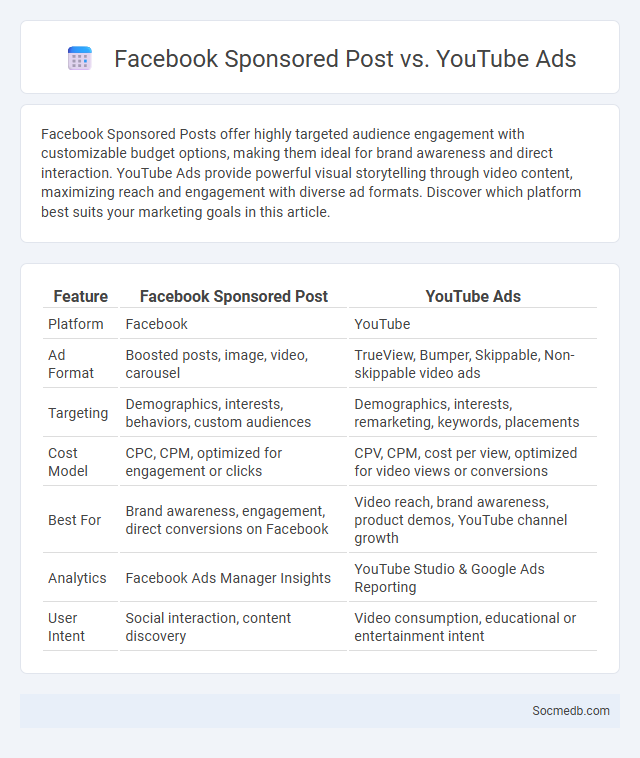
Photo illustration: Facebook Sponsored Post vs YouTube Ads
Facebook Sponsored Posts offer highly targeted audience engagement with customizable budget options, making them ideal for brand awareness and direct interaction. YouTube Ads provide powerful visual storytelling through video content, maximizing reach and engagement with diverse ad formats. Discover which platform best suits your marketing goals in this article.
Table of Comparison
| Feature | Facebook Sponsored Post | YouTube Ads |
|---|---|---|
| Platform | YouTube | |
| Ad Format | Boosted posts, image, video, carousel | TrueView, Bumper, Skippable, Non-skippable video ads |
| Targeting | Demographics, interests, behaviors, custom audiences | Demographics, interests, remarketing, keywords, placements |
| Cost Model | CPC, CPM, optimized for engagement or clicks | CPV, CPM, cost per view, optimized for video views or conversions |
| Best For | Brand awareness, engagement, direct conversions on Facebook | Video reach, brand awareness, product demos, YouTube channel growth |
| Analytics | Facebook Ads Manager Insights | YouTube Studio & Google Ads Reporting |
| User Intent | Social interaction, content discovery | Video consumption, educational or entertainment intent |
Introduction to Social Media Advertising
Social media advertising leverages platforms like Facebook, Instagram, Twitter, and LinkedIn to target specific audiences with tailored content, boosting brand visibility and engagement. Your campaigns benefit from advanced targeting options based on demographics, interests, and behavior, ensuring optimal ad spend efficiency. Understanding ad formats, bidding strategies, and analytics is essential to maximize return on investment and drive measurable business growth.
What Are Facebook Sponsored Posts?
Facebook Sponsored Posts are paid advertisements that appear within users' news feeds, designed to increase the visibility of content beyond organic reach. These posts target specific audiences based on demographics, interests, and behaviors using Facebook's advanced ad targeting tools. Sponsored posts help businesses and brands boost engagement, drive traffic, and promote products or events effectively on the platform.
Understanding YouTube Ads
YouTube Ads offer targeted advertising options utilizing Google's comprehensive data to reach specific audiences based on demographics, interests, and behavior. Formats include skippable in-stream ads, non-skippable ads, bumper ads, and sponsored cards, each designed for varying engagement goals and budget sizes. Advertisers can optimize campaigns through detailed analytics and A/B testing to maximize ROI and enhance viewer interaction.
Defining Sponsored Posts Across Platforms
Sponsored posts across social media platforms like Instagram, Facebook, and Twitter are paid content designed to promote brands, products, or services while blending seamlessly with organic posts. These posts are labeled as "sponsored," "paid partnership," or "promoted" to maintain transparency and adhere to advertising guidelines. You can leverage sponsored posts to target specific audiences, increase brand visibility, and drive engagement effectively.
Audience Targeting: Facebook vs YouTube vs Sponsored Posts
Facebook offers advanced audience targeting with options like custom audiences, lookalike audiences, and detailed demographic filters to reach your ideal customers. YouTube leverages Google's data to target viewers based on search behavior, video engagement, and interests, making it effective for reaching broader and intent-driven audiences. Sponsored posts across platforms provide native ad experiences with flexible targeting but often lack the granular controls found on Facebook and YouTube.
Cost Comparison: Facebook, YouTube, and Sponsored Posts
Facebook advertising costs typically range from $0.50 to $2.00 per click, offering targeted options for diverse demographics. YouTube ads average around $0.10 to $0.30 per view, benefiting from high engagement through video content. Sponsored posts on platforms like Instagram and LinkedIn vary widely, with prices influenced by audience size and niche, often starting at $50 for micro-influencers and scaling exponentially.
Ad Formats and Creative Flexibility
Social media platforms offer diverse ad formats including image ads, video ads, carousel ads, and stories, allowing marketers to tailor campaigns to various audience preferences. Creative flexibility enables brands to experiment with interactive elements, augmented reality filters, and dynamic content to boost engagement and conversion rates. Leveraging platform-specific features like Instagram Reels or Facebook Instant Experience enhances user interaction and campaign performance.
Engagement and Reach Metrics
Social media engagement metrics, including likes, comments, shares, and saves, provide crucial insights into how effectively your content resonates with your audience. Reach metrics measure the total number of unique users exposed to your posts, helping you understand the breadth and visibility of your social media presence. By analyzing both engagement and reach, you can optimize your strategies to boost interaction and extend Your brand's online influence.
Pros and Cons of Each Advertising Strategy
Social media advertising strategies vary in effectiveness depending on the platform and target audience, with influencer marketing excelling in authenticity and trust-building but often requiring significant budget and vetting. Pay-per-click (PPC) campaigns on platforms like Facebook and Instagram offer precise targeting and measurable ROI, though they can suffer from ad fatigue and higher costs in competitive niches. Content-driven ads such as videos and stories engage users through interactive formats, yet risk being ignored if not creatively aligned with user interests or platform trends.
Choosing the Best Platform for Your Campaign
Selecting the best social media platform for your campaign hinges on understanding your target audience's demographics and engagement habits. Platforms like Instagram and TikTok excel in reaching younger audiences with visually-driven content, while LinkedIn offers robust options for B2B marketing and professional networking. Analyzing platform analytics and aligning campaign goals with each channel's strengths ensures maximum reach and conversion rates.
 socmedb.com
socmedb.com